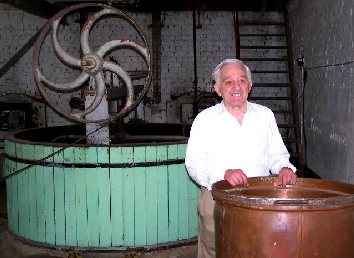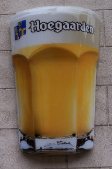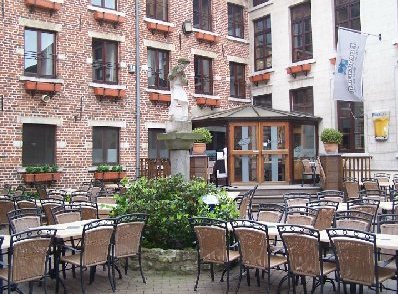 |

|
|

|
|
|
 |

home
about
features
A-Z
books

|

|

Protz:
features
reviews
tastings
|

| |
Pierre Celis, Maestro of White Beer
by Willard Clarke, 06/05
PIERRE Celis has been so badly mauled by global brewers that it was good to find him sprightly and cheerful at his home in the Belgian town of Hoegaarden and, at the age of 81, preparing to start making beer all over again.
It was Pierre who saved and revived a noble beer style: the spiced wheat or "white" beers of East Brabant. The region has rich, dark soil ideal for growing barley, oats and wheat.
Brewing in the area has been traced back to 1318, when it was in the hands of farmers and monks. By the 1500s Hoegaarden had a brewers' guild and in the 19th century there were some 30 breweries in the small town.
Right: Pierre and his wife, Juliette.
The special character of the white beers of Brabant was due to the use not only of wheat and oats alongside barley malt but also exotic spices and fruits brought to the Low Countries by Dutch and Flemish traders. Spiced white
beers from Hoegaarden were widely distributed throughout Brabant and the neighbouring province of Liege.
|
|

|
But in the 20th century the breweries started to close, unable to compete with the mass-marketed Pilsner lagers produced in the city of Leuven, home of Stella Artois.
The last brewery in Hoegaarden, Tomsin, pulled down the shutters in the late 1950s. It was mourned by many in the town, including Pierre Celis, who had done some part-time work there as a schoolboy.
Pierre's father ran a dairy and Pierre delivered milk. He was drinking in a bar with some friends one evening and they began to reminisce about the much-missed beers of Hoegaarden. Encouraged by his friends, who jokingly said
he should move from one cloudy white drink to another, Pierre said he would attempt to brew some beer. He made a batch in his wife's copper in the family home alongside the dairy. There was no written-down recipe from
Tomsin's, but Pierre remembered the ingredients from his work there. Grain and hops were easily available and he added milled coriander seeds and Curacao orange peel.

|
|
His beer was so well received that he decided to make it commercially. In 1966, he bought a small 25-hectolitre plant from a brewery in Limburg and installed it in the stables next to the house. The kit is still there today, but the
success of the beer forced him to move to a derelict lemonade factory in the town to cope with demand.
Left: Pierre with the original brewing equipment in the stables of his home in Hoegaarden where he first brewed his White beer.
|
The cloudy, unfiltered beer had taken Leuven by storm, where university students considered it to be more natural than lager. Pierre broke into the important Antwerp market and then into the Netherlands and France.
The beer's fortunes were aided by the unique eight-sided glass: by chance, Pierre had found the Italian prototype in a local shop (shown below, right).
Production grew rapidly to 300,000 hectos a year by 1985. Pierre had just started to export to the United States when fire devastated the brewery. He was seriously under-insured.
"I needed 280 million Belgian francs to rebuild but I only got 40 million from the insurers," he says. "The banks wouldn't help but then Stella Artois offered to invest in return for 45 per cent of the shares."
At first the relationship with Stella was a good one. But things changed dramatically in 1988 when Stella merged with Piedboeuf of Jupille near Liege. |
|

|
Interbrew was born and, according to Pierre, "the bankers took over". The
fact that they were French-speaking bankers probably didn't help.
"People came from Jupille, looked around the brewery and told me how to make my beer cheaper. They said they used high-gravity brewing at Jupille to reduce costs and I should do the same," he says.
Pierre refused. High-gravity brewing means making one strong wort and watering it down to make different beers. Pierre, who had added to the range at Hoegaarden, said it would give his beers different aromas and flavours.
He declared he would stick to his old recipes and ways of brewing.
As the pressure mounted, and Interbrew began to close breweries in Belgium to concentrate production at Leuven and Jupille, Pierre decided to retire at 65, selling the company to the Belgian giant.
But that wasn't the end of the story. American interest in Hoegaarden prompted him to build a brewery in Austin, Texas. Celis White was an overnight success and sales boomed. But Pierre found that his American backers
wanted a quick return on their investment and, in order to buy them out, he signed another Faustian pact, this time with Miller, America's second-biggest brewer.
"I'd been brewing 22,000 barrels a year," he says, "but that rapidly fell to 15,000 barrels when Miller arrived. They spent a fortune on administration and we lost money and production. They cheapened the beer and cut out
imported Czech hops."
Pierre sold his share of the company and came home to the family house in Hoegaarden with his wife Juliette. Miller eventually closed the Austin brewery and now Pierre finds that InBev, the successor to Interbrew and the
world's biggest brewer, plans to close the Hoegaarden plant in October.
It has nothing to do with lack of success - the brewery is now producing a million hectos a year - and everything to do with InBev's centralising frenzy. With astonishing insensitivity, it will move production of the Hoegaarden
beers not to nearby Leuven, a Flemish-speaking city, but to the Jupille plant in French-speaking Wallonia some 70 miles away. Left: The entrance to the Hoegaarden brewery, scheduled to close in autumn 2006.
|
|

|
Last December the citizens of Hoegaarden held a rally in the town to protest against the closure of the brewery. Many windows still carry posters for the rally with the simple message, in Flemish, "Hoegaarden brews Hoegaarden".
"All the people in the town find it difficult to understand there will no longer be a brewery in Hoegaarden," Pierre says. "People have asked me to brew again but I won't. InBev owns the name of Hoegaarden, controls distribution and ties up the bars. InBev is also launching a new white beer called Peeterman, brewed at Leuven. Is there room for two white beers? Will they both survive?"
But Celis White is about to reappear in the US. Pierre has joined forces with the Real Ale Brewery in Blanco, Texas, and will launch a wheat beer this summer called Brussels Grand Cru. They can't use Celis in the name because Miller owns it but, with pleasing irony, Blanco means "white" in Spanish.
This time there will be no pacts or deals with big brewers. "They're bankers not brewers," Pierre insists. "They buy you out and then they kill you."
In spite of Pierre's reservations, though, a new brewery is indeed being planned in Hoegaarden. Pierre Celis at 81 is a mere stripling compared to Albert Guilluy, who will be 90 in July, and is organising the plans for the new enterprise. He ran the Hoegaarden Brewers' Guild for many years and helped drill the borehole for Pierre's brewery.
It is rumoured that Pierre is offering "technical assistance", but he denied this when I met him. This may be the result of treading carefully to avoid legal action. InBev owns all the rights to Hoegaarden beers and the corporate lawyers will bring in the tanks if anyone launches a rival brand.
Get ready for another Budweiser versus Budweiser confrontation and support David, not Goliath.
|
|
home
about
features
A-Z
books
|

